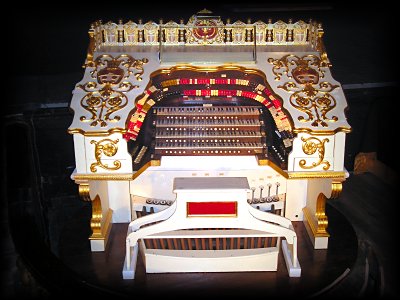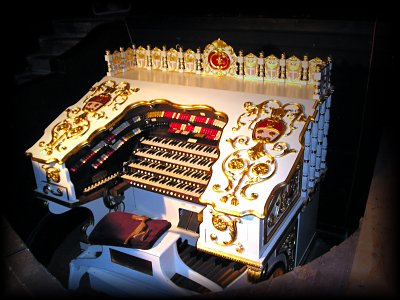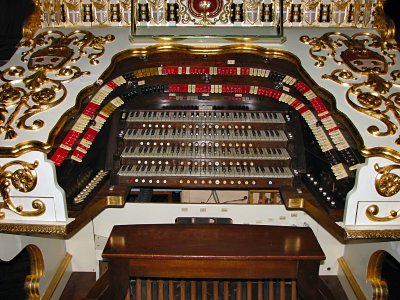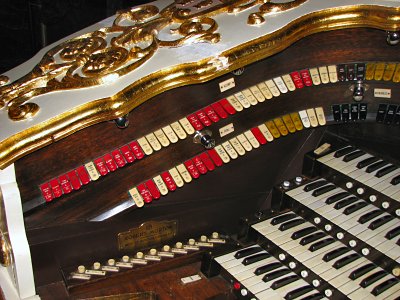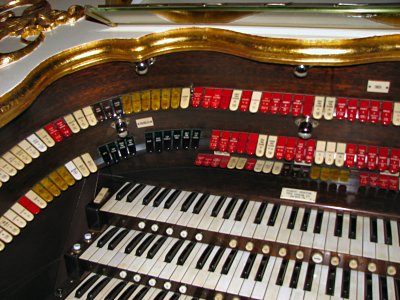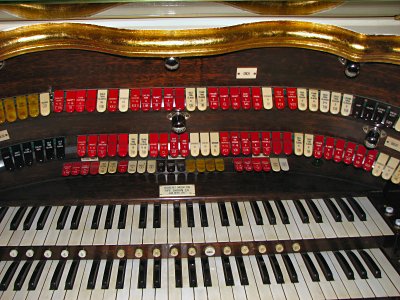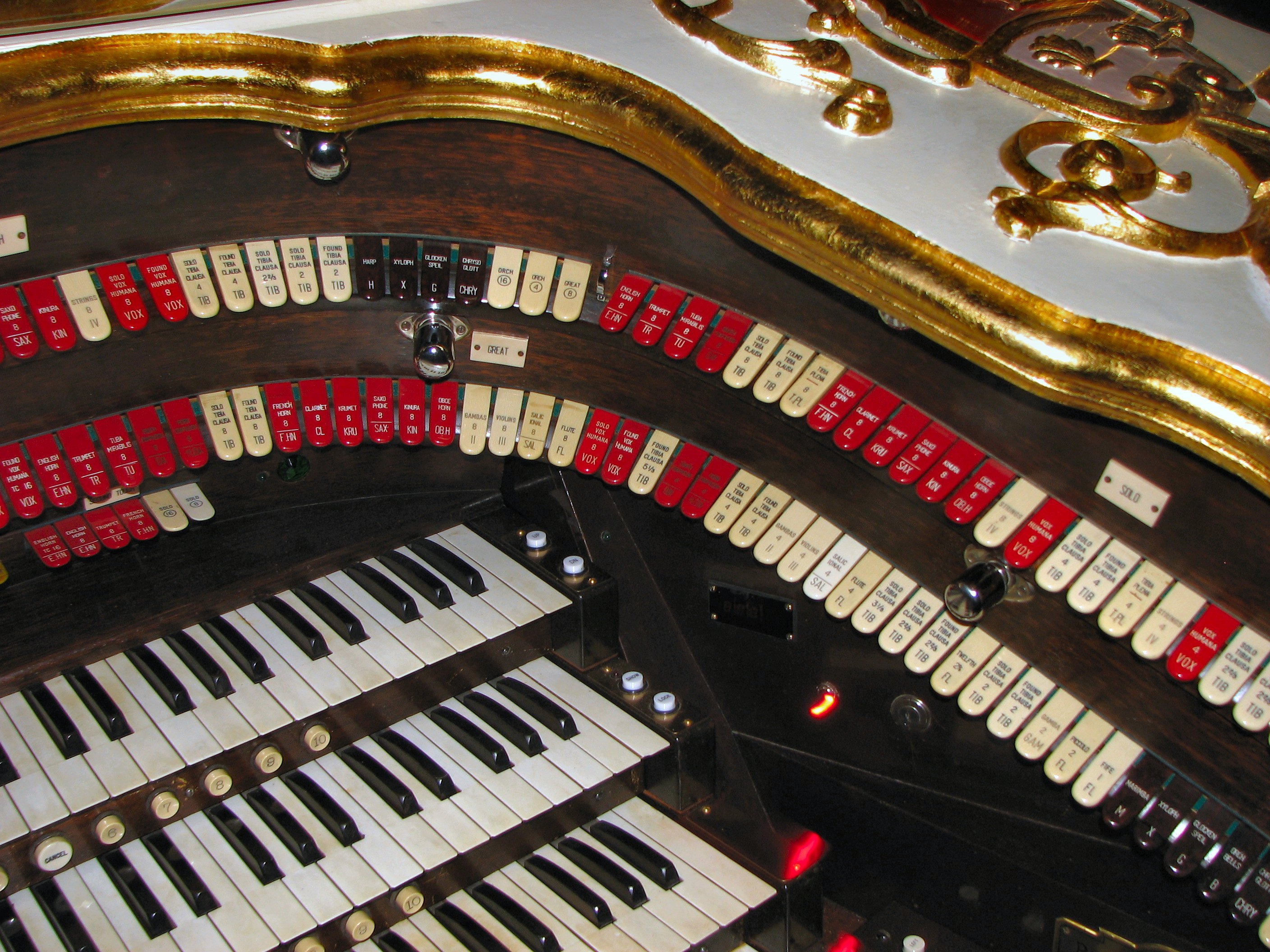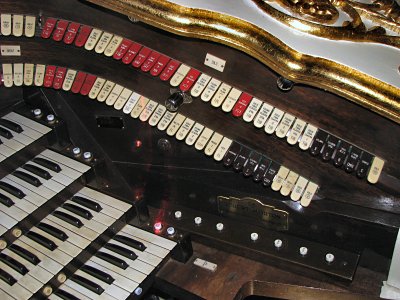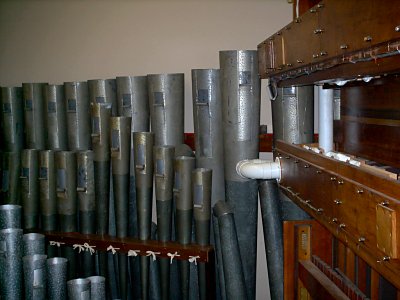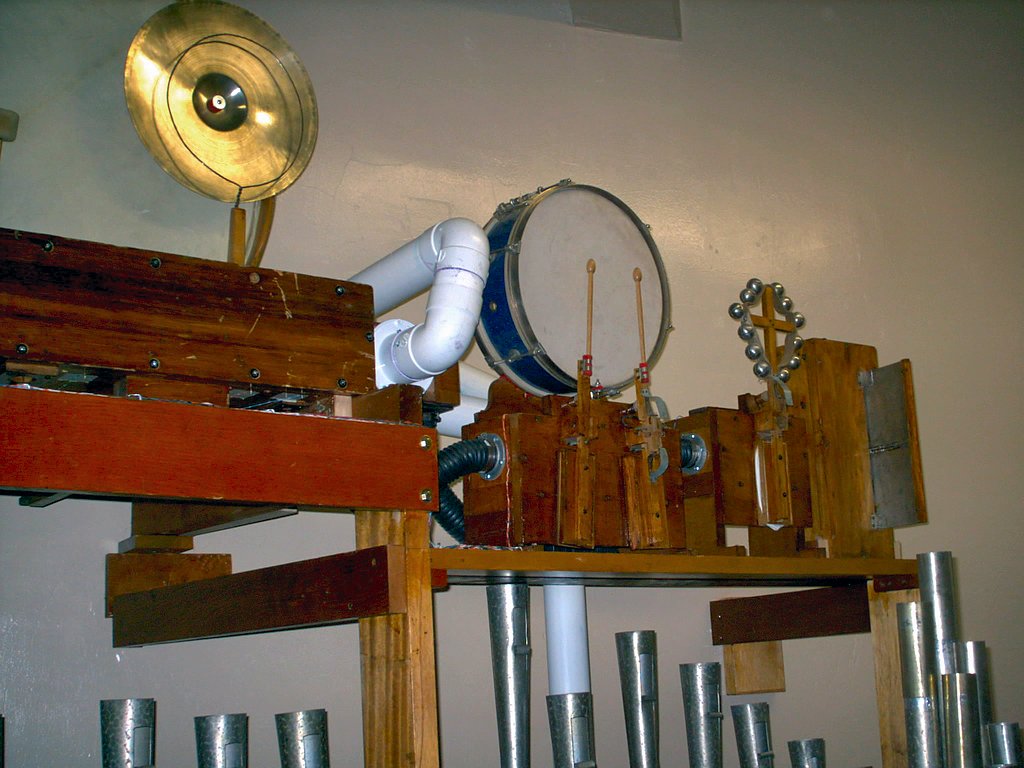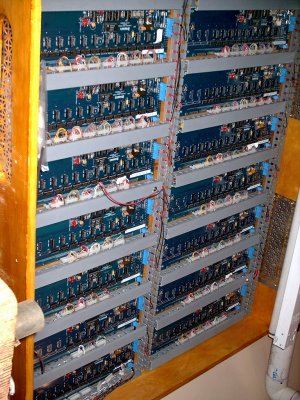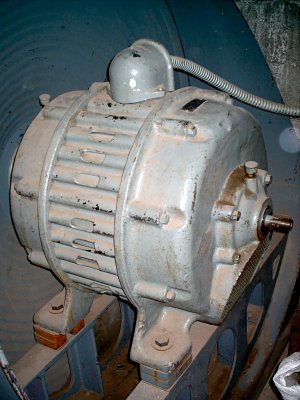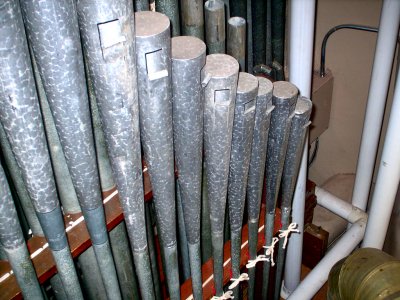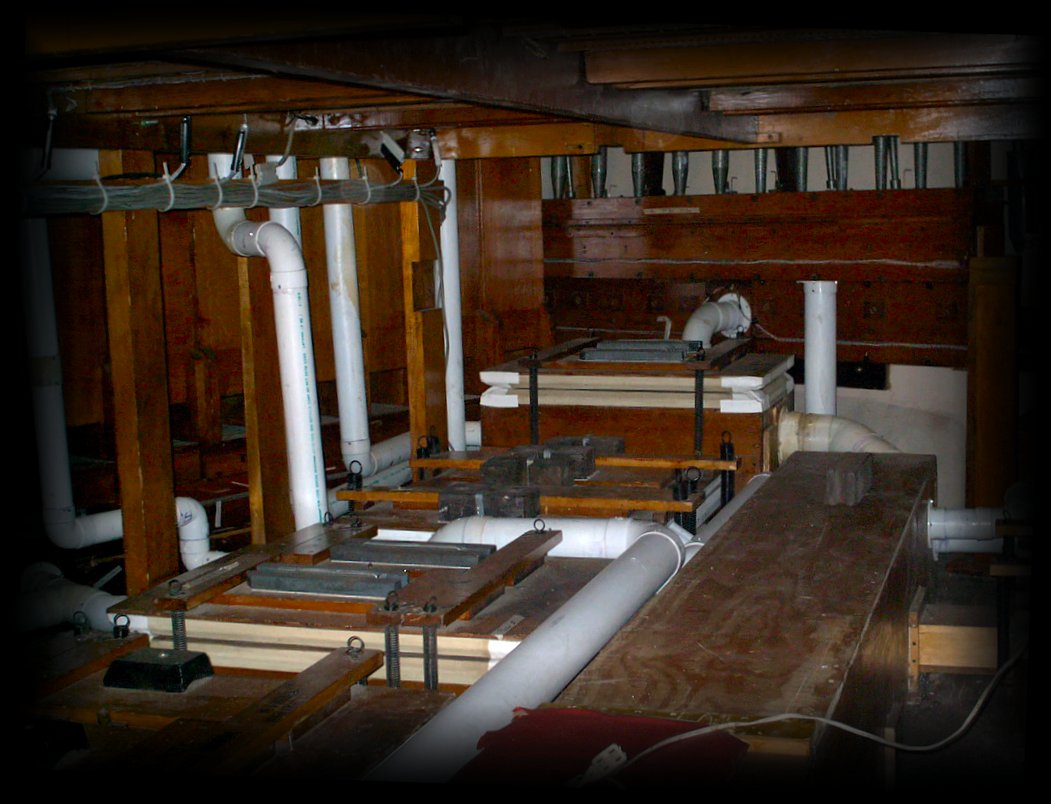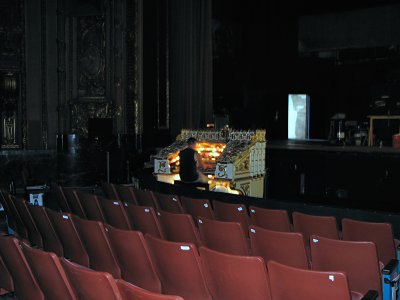
|
|
Loew's Jersey Theatre
|
|
This month's featured organ is the Bob Balfour Memorial 4/23 Wonder Morton Theatre Pipe Organ installed at Loew's Jersey Theatre, Jersey City, New Jersey. It is the fifty-first organ to be featured at Walnut Hill. We are very fortunate to have lots of great material on this lovely machine, including lots of video, many pictures, a wealth of information and some wonderful audio recordings for all to enjoy, provided by Eurgene Hayek and Tom Hoehn. |
A Closer Look at the Console |
|
The original organ in the Loew's Jersey was removed in 1974. It was, however, one of five identical instruments, christened “Wonder Mortons”, that were built by the Morton Organ Company to be installed in five theatres that the Loew's company was building in the late 1920s. The Loew's Jersey was one of these five “Wonder Theatres". Another was the Loew's Paradise in the Bronx. That Theatre's organ was also removed in 1974, winding up in the possession of a private collector who stored it in a Chicago warehouse for some twenty years. In 1997 the Garden State Chapter of the American Theatre Organ Society found the Paradise organ and managed to acquire it so that it could be put on permanent loan to the Loew's Jersey Theatre.
Here you see the console of this magnificent organ. What you don't see in this picture are the hundreds of pipes and other noise-makers that are also part of the huge instrument. Those parts are assembled in two large rooms behind ornately decorated grills on either side of the auditorium stage. Do not confuse a Theatre Pipe Organ with its more staid cousin of classical roots, the Church Pipe Organ. Theatre Pipe Organs can, of course, produce beautiful and sometimes somber music. But unlike their church brethren, they can also produce a prodigious array of sound effects, everything from trumpets to cow bells to car horns to train whistles, hence the old saying "all the bells and whistles". The Wonder Morton has four manuals and twenty-three ranks of pipes for a total of 1,774 pipes, some of which are as big as trees at sixteen feet long and others only five inches long, no bigger than pencils. It has 228 stop tongues in the console, over 9,000 electrical connections and many miles of wire. The pipe work is located up in the theatre walls on ether side of the proscenium arch above the stage. These pipes speak through two beautifully decorated archways, each one having a custom chandelier hanging in the center of the opening. The organ has a massive twenty-five horsepower blower located in one of the lower levels of the Theatre. The entire instrument weighs approximately twenty-four tons.
Since the Loew's new/old organ arrived with great fanfare in July 1997, volunteers from the Garden State Theatre Organ Society have been rebuilding the organ's many wooden parts and replacing miles of control cable. By 2002, the Wonder Morton was fully operational. When the Friends of Loew's, a non profit group of volunteers, took over the shuttered theatre and started the renovation of the building, Bob Balfour, a dedicated member of Garden State Theatre Organ Society, began to lobby the theatre group to install the Paradise organ. After a few years the deal was made and the Garden State Theatre Organ Society bought the organ and brought it to Jersey City for the humongous task of rebuilding, designing the installation and installing it in the theatre. This huge task was performed by a dedicated number of volunteers.
Here, we see the Left Bolster of the horseshoe. Note the row of pistons along the bottom of the Bolster below the Robert Morton nameplate. This is a Robert Morton trademark design. They control various sound effects and traps such as sirenes, birds, wind, bells and whistles.
Here, we see the left curve of the horseshoe. On most pipe organs, the tremulant stops are white. Robert Morton chose to use black stop tongues instead, seen on the bottom row of tongues in the middle of the curve.
Here, we see the stops along the center of the horseshoe. Note that Robert Morton did not use the same color scheme for the stop tongues that WurliTzer used. The Flues including Tibias, Flutes and Strings, are white. The Reeds are red with white lettering. The Diapasons are red with gray lettering. The Percussions are mottled yellow. But like most organs, the couplers are black.
Here, we see the right curve of the horseshoe. Note that the radius of the horseshoe curves is fairly small leading out to a straight long rail toward the ends of the horseshoe. This allows many more stops to be placed in the Bolsters, while still being easy for the organist to reach.
Finally, we come to the Right Bolster of the horseshoe. The row of pistons along the bottom of the Bolster in front of the Robert Morton name plate control the lift. It can go up or down, and move left or right. There are also two pistons on the key cheek that set the crescendo pedal for two different sets of voices. Note the rocker tab below that sets the Solo swell shoe to be Solo only or Master so that the entire organ can be controlled from one shoe. |
A Closer Look At The Chambers |
|
After years of rebuilding, designing, and installing the organ, on Saturday July 14, 2007 the switch was finally thrown and the organ came alive to sound again in a Loew's Wonder Theatre as it was designed to do 78 years ago. The organ, the soul of the theatre, already sounds beautiful even in its infant stages of tuning and debugging. The instrument is scheduled to formally open in October of 2008. To learn more about this inaugural concert that promises to be a box office hit, click here.
To see more shots of the organ and the chambers, along with the restoration work being done, click on a link below which will take you to any of the various photo albums posted on Flickr.com by the folks who are working on this wonderful instrument.
One of the charactoristics of a Mighty Robert Morton Theatre Pipe Organ that sets them apart from other makes is the large scale pipework. These large pipes give the instrument a tone that is outstanding in volume, sweetness and clarity. The sound is quite orchestral, and the listener can easily forget they are listening to an organ, thinking it is a full blown symphony orchestra instead. Wind in the instrument is controlled by large boxes with lids attached by bellows, called regulators. In the photo above, we see some of these devices. Wind enters the boxes through the white pipes and as the pressure rises, the lids move upward. Springs and weights try to hold the lids down. As air rushes out when notes are played, the pressure drops causing a valve inside to open, replacing lost air back into each box, keeping the pressure inside even all the time. |
A Closer Look at the Theatre |
|
The Loew's Jersey opened on September 28, 1929, with the movie Madame X, not exactly a Hollywood Legend. But the magnificent building it premiered in was, and still is, a Movie Palace.
Remember that when the Loew's was built, luxury was even less a part of ordinary life than it is today. The songs, dance numbers and comedy routines that people enjoyed on the Loew's stage and screen were for many of them the biggest luxuries in their lives. But the builders of Movie Palaces like the Loew's Jersey wanted to make sure that the uplifting power and glory of the performing arts spilled past the proscenium arch to have an even bigger impact on audiences. The idea was to make a theatre building so spectacular that it became part of the show.
The designers of the Movie Palaces borrowed architectural forms from the palaces of European royalty and the estates of America’s most wealthy to create extravagant showplaces for the common man, woman and child. “It is opulence unbound, but opulence with a purpose,” said George Rapp, architect of the Loew's Jersey and dozens of other Movie Palaces. He went on to explain that this purpose could be seen in the face of the tired shop clerk who came to one of his theatres for relief after a long day, or in the eyes of a father who had brought his children to a show after working a double shift. “The rich rub elbows with the poor here, and are better for it” he concluded. From the moment a patron crossed the threshold, he was supposed to be cut off from his ordinary world and made to feel special because he was now in an extraordinarily lavish setting where he was welcome. And from the grandeur of the ornate walls and crystal chandeliers that now surrounded him, he sensed the wonder of the performance he was about to enjoy.
Even the outside of the Loew's Jersey Theatre was meant to be striking. Here you see the Theatre as it appears today. The marquee was changed in 1949, but the current one, like its predecessor, is an extravagance of bright and flashing light and neon. The vertical sign was removed in the mid-1960s, but the ornate terra cotta facade remains. The builders of the Loew's wanted to attract plenty of attention to the building. And what better way to attract attention in busy Journal Square where thousands of commuters and shoppers were hurrying by than with a big clock? But not just an ordinary clock. Above the large round clock face at the center of the Theatre's facade is an arched cupola in which stand a copper statue of St. George and his mythical nemesis, The Dragon. This clock was made by famed American clock manufacturer Seth Thomas and is one of only a very few moving-figure tower clocks on the Eastern Seaboard. Every fifteen minutes The Dragon would rise up and down as he reared over St. George, his mouth opening and closing menacingly. At night, a red bulb shown in his mouth. St. George would respond by moving his arm forward to lance The Dragon, which would fall “dead away” to a low position. These movements were accompanying by the ringing of two bells that chimed out the quarter hour.
As you enter the Theatre, you pass the ornate bronze ticket booth and go through two sets of heavy brass doors. The chandelier in the Grand Lobby is made of Czechoslovakian crystal and reputedly cost $50,000 to make in 1929. If you’re wondering how it is cleaned and re-lamped, the answer is that it must be lowered. It takes three people twenty minutes to carefully lower the fixture by slowly turning a winch located above the ornate ceiling. It takes three times as long to haul it back up. A visitor once remarked that seeing the Grand Lobby of the Loew's is like standing inside a Faberge Egg. looking straight up at the ornate ceiling gives you an idea what he meant. You are surrounded by wonderful interpretations of baroque forms.
You may notice the faux private boxes that line the walls of the auditorium. They were never meant for people to sit in -- there’s no room behind the fancy frame you see in the photo. Most Movie Palaces didn't have private boxes because the idea of such exclusivity runs counter to the more democratic ideals of the Movie Palace. But private boxes were part of the design of grand European opera houses, and the architects of the Movie Palaces wanted you to feel as if you were sitting in such an elegant and exclusive hall.
In the picture above, we are standing at center stage, enjoying the view performers see as they look out toward the audience. All the domes and coves are equipped with a three-color lighting system that is controlled from the stage light control board. These house lights can be mixed and dimmed to create different moods in the auditorium to match different shows. Note the white line at the center of the balcony rail. In 1974, the Loew's was converted into a triplex. Plain sheet rock walls were constructed to cut the ornate auditorium into three small cinemas. One wall was built straight across the orchestra floor at the balcony line. Another was built perpendicular to the first down center aisle. But as terrible as this may seem, the damage is really minor and can be repaired with relative ease by taking casting of other areas of the ceiling and making replacement moldings to fill in this gouge. To see the complete nine page virtual tour of this grand movie palace, from whence these pictures and information in this section of our feature were taken, click here. |
YouTube Videos
|
Tom HoehnTom Hoehn, Vice President of the Walnut Hill Organ Club and Featured Artist, went to New York to attend the concert that was given at Radio City Music Hall by Jack Moelman and friends on August 9th of 2008. A few days before the show, he was fortunate to get to play this fine instrument. Eugene Hayak, fellow Wall of Fame member and Featured Artist, took along his Aptek video camera and recorded some selections from the performance.
|
Other YouTube Videos |
Sue Ward
Ralph Rigstadt, Jr.A native of Whippany, New Jersey, Ralph Rigstadt, Jr. began his formal musical training at the age of seven. By seventeen he was performing along with Frank Cimmino on the 3/17 Wurlitzer at the Suburbian Restaurant in Wanaque, New Jersey. By eighteen, while a student at Ithaca College from which he earned a degree in music, he had made his concert debut on the 4/33 Möller Theatre Pipe Organ at the New York Military Academy.
A multi-talented musician, Ralph’s formal musical training includes not only classical and theatre organ, but also piano, cello, French horn and tuba. He has performed extensively on the tuba with orchestras and concert bands throughout New Jersey and New York. Ralph has concertized at many of the top theatre organ venues throughout the country including the Senate Theatre in Detroit, Long Island University, the Trenton War Memorial, the Thomaston Opera House, and Rochester Auditorium. He has served as Organist and Music Director for several churches in North Jersey, and can be heard locally playing a series of classic and silent films on a theatre organ at various locations. He is currently the House Organist at the Loew's Jersey Theatre. Ralph has recorded a popular CD entitled One of A Kind on the Trenton War Memorial’s 3/16 Möller Theatre Pipe Organ.
Loew's Jersey Channel
|
Free Music Downloads From Tom Hoehn |
|
On August 7th, Tom Hoehn ventured out to the theatre to take the bench for a few hours, eager to play this enormous organ. He set up his trusty Zoom H4 Digital Audio Recorder and gave the old gal a go.
|
